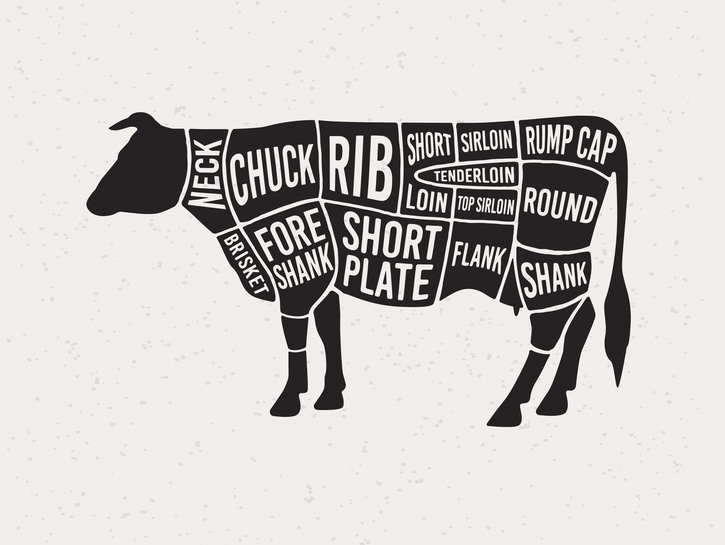The Basics
When talking about the different cuts of beef, it’s important to know the vocabulary for describing the sections. “Primal” beef cuts refer to the larger divided sections, which are from there broken down into smaller muscle groups, or “subprimal” cuts. Out of these smaller sections, steaks, roasts, ribs, and other cuts are sliced off and sold at restaurants or in grocery stores.
A “side” of beef is literally a single half of the cow split evenly down the backbone. Both sides are then halved again between the 12th and 13th ribs, with everything before the 12th rib being called the “forequarter” (the front part of the cow), and everything after the 13th rib being referred to as the “hindquarter” (the back part of the cow).
As a general rule, the most tender meat will come from the areas furthest from the horn and hoof, like the rib and tenderloin. Whereas the toughest meat comes from the shoulder and leg since the animal strains those muscles most often.

PGMart/Shutterstock
Forequarter Cuts
Chuck
Neck to the 5th rib
Beef chuck is a primal cut sourced in the forequarter and is made of parts of the neck, shoulder, and upper arm. Chuck meat has a lot of connective tissue which makes it tough, though it is often tenderized. This meat also has a high-fat content and is used frequently as a source for ground beef.
The chuck can be further divided into four subprimals – the neck, blade, shoulder, and cross rib.
Rib
6th to the 12th rib
The beef rib refers to the top center section of the cow ribs. This primal cut is the source of prime rib, rib eye steaks, and entrecote sirloins. Beef rib meat is naturally tender, which means it can be grilled, fried, broiled, roasted, or barbecued and maintain its texture.
Brisket
Breastbone area
Extremely flavorful but tough and fatty, the brisket is the cow’s equivalent of chest muscles. Brisket requires very specific preparation, typically quite slow and low-temperature. Often used for making pot roast and corned beef, brisket is also frequently barbecued or smoked. The brisket can be divided into two subprimals, the brisket point, and brisket plate.
Shank
Thigh muscles
The beef shank is the thickest part of the cow’s leg. Both sides of beef have two shanks, each with a forequarter (foreshank) and hindquarter (hindshank). The cow is using its legs constantly, so the shank is packed with connective tissue and tends to be tough and dry.

Steve Wood/Shutterstock
Hindquarter Cuts
Short Loin
End of ribs towards the back
The short loin is only 16 to 18 inches long, but contains the most desirable cuts of meat, including the T-bone, porterhouse steaks, and striploin. The first steaks cut from the short loin will be bone-in strip steaks, followed by the center-cut steaks (T-bones), and lastly a couple porterhouse steaks will be cut from the short loin.
The tenderloin muscle actually intersects with the short loin, and if the tenderloin is removed, T-bone or porterhouse steaks cannot be cut since both steaks require a section of the tenderloin.
Tenderloin
Located within the loin
The most tender cut of all, this cut is sourced from the cow’s loin. Filet mignon, for example, is made from the pointed tip of the tenderloin. The muscle extends into the short loin but can be removed and sold separately. Tenderloin doesn’t need to be cooked for long since it’s already very tender, so high temperatures and quick cooking times are encouraged.
Flank
Abdominal muscles
The bottom back portion of the cow, the flank has some dense muscles that can make the meat quite tough if not prepared correctly. Flank steaks are best cooked at a very high temperature for a short period of time on the grill. This meat is best cut against the grain of the muscle fibers to promote a tender texture.
Round
Rear leg and rump
A primal cut consisting of the back leg portion of the body, these muscles are tough as they get a lot of exercise.
There are three main subprimals of the round section: the top (“inside round”), the bottom (“outside round”), and what’s called the knuckle. The top and bottom round are classified as “lean”, and don’t contain a lot of collagen, a protein that turns into gelatin.
